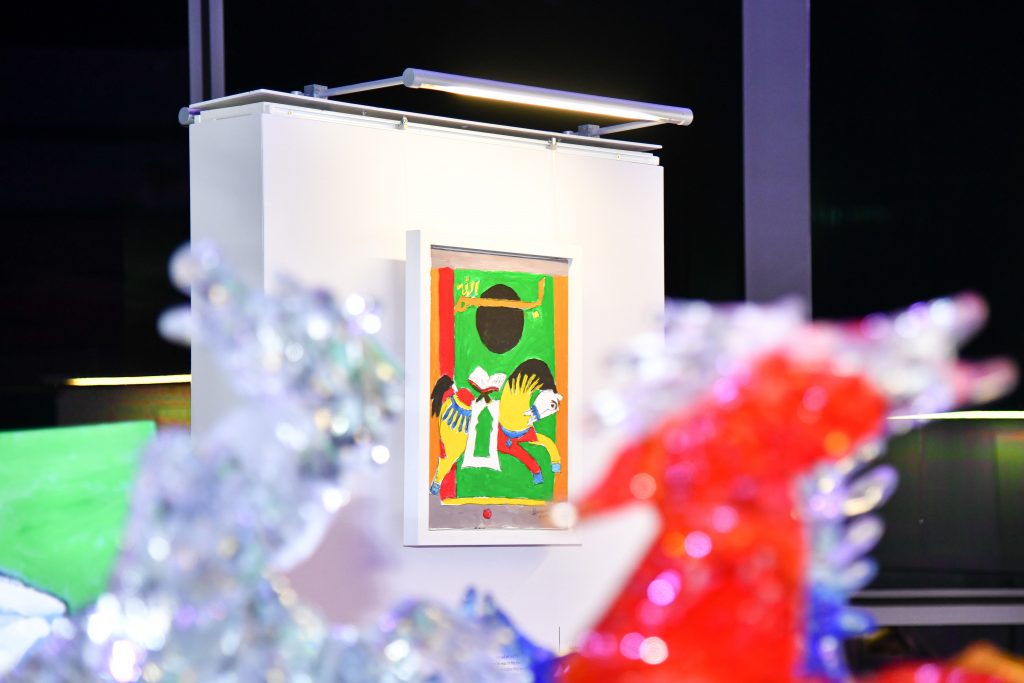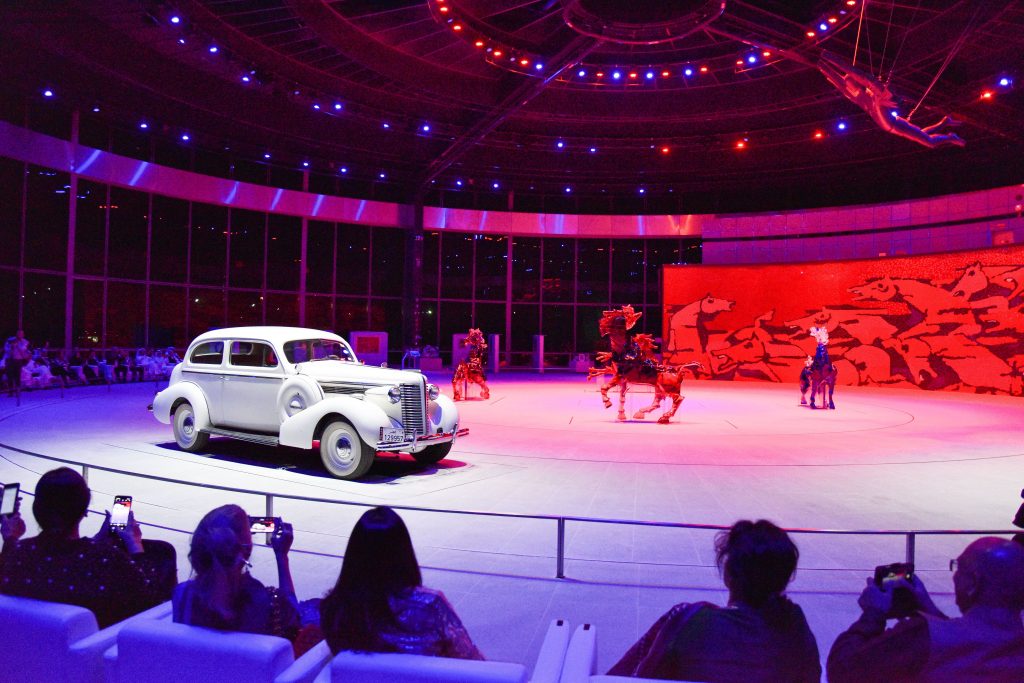M.F. Husain’s Last Work of Art
Seeroo Fi al Ardh, the final artwork of Maqbool Fida Husain highlighting the progress of humanity on land, air, and sea, is a discerning display of creativity and resourcefulness of this fine artist who fled India, the country of his birth, to find solace in a country, Qatar, that embraced his creativity in all its diversity. His final artwork is on display at a custom-built structure within Education City, Doha, Qatar. By Sindhu Nair
Just when you thought you had seen the finest work of the Indian ace artist M.F. Husain, Qatar Foundation springs another surprise on us. This masterpiece is not like any of the earlier works that Husain has produced, instead, it is a culmination of his creativity, poured into diverse mediums to tell the story of mankind and how he has traversed the world to conquer science and decipher its mysteries. This artwork, brought to life almost a decade after the death of this artist, seems to be illustrative of Husain’s life and creativity; borderless, infinite, and perpetual in nature.

In this model, M.F. Husain has recreated the large installation in smaller dimensions and he called this artform, Form Follows Function.
- The other paintings of Husain’s that adorn the space. The first one, Basmallah, 2007, is reflective of the artists’ toymaking period in Mumbai; This painting of Husain depicts the various religions of the world.
For me, personally, the installation and the artwork leading to it touched a chord, not because of the creativity involved, which is intricate and had the magic touch of Husain’s brush, but because the exhibition also had letters that Husain wrote to HH Sheikha Mozah, explaining his ideas and in which his adoration for HH Sheikha and what she stood for is evident. The letters all of which are in Husain’s own handwriting, are a work of art in itself, for his letters are calligraphic in nature with each tilt arty in its flow and to add to it, Husain also added his sketches and drawings to it. But what touched me most, were the wordings, the honesty, and integrity they seemed to convey, an almost child-like belief and passion for art and humankind in general. He signs off one such letter to HH Sheikha Mozah thus, “Please consider me a small soldier in the army of your cultural force.” That this was written by an artist whose only wish, in his words was, “to work in peace…” A wish that seemed to have been granted by HH Sheikha Mozah and hence his gratitude…

Layla I. Bacha, Senior Art Specialist, Strategy, Administration and Project at Qatar Foundation, introducing the work of art to selected members of QF during the launch of the installation.
The installation touches on how people used nature, and then later machines, to further their ambitions. And it highlights the fact that the enlightened mindset that sparks innovation and experimentation existed in the Arab world both before and during the European Renaissance.

Dancing horses in Murano crystal, framed by an elaborate mosaic work of horses by Husain, with the Flying Man hanging from above.
This is an artwork imagined to be both kinetic and experiential. Husain visualized the installation in one of his sketches from 2009, having a mosaic wall painting of around 40 horses, a bronze sculpture of Abbas ibn Firnas, the first scientist of the Arab world, reputed to have made one of the earliest recorded attempts of flight in the 9th century, suspended from the ceiling, a bronze sculpture of da Vinci’s flying machine, originally sketched in the 16th century, inspired by the mechanics of winged animals, five coloured glass horses, and five vintage cars, loaned from Sheikh Faisal Bin Qassim Al Thani Museum displayed on a circular rotating platform around the artwork. The mosaic artwork that forms the backdrop of this installation is made from Trencadís, which is also known as broken tile mosaics.
- During the opening night of the installation. with all the vintage cars on display along with the work of art by Husain.
In his own words, “the entire ensemble is like a performance of dancing horses in crystal glass set to the tune of the traditional song of horsemanship, chivalry, and strength”. Each part of the ensemble was clearly explained, scaled and all dimensions set to detail in the drawing that Hussain kept ready, which is also in display along with a physical small scale installation, with his personal handwritten inscription giving all the specifics needed to bring it to completion, almost as if the artist suspected his own mortality before the completion of the project.
The carousel is housed in a building envelope that is 46 m in diameter with a total building height of 12 metre. The glazed facade consists mainly of 6 single curved glazed modules. The envelope itself is supported by a structural steel system. The Art Carousel’s kinematic mechanism is housed in a basement structure sitting under the pavilion building, with each element, the glass horse and the vintage cars, coming up from the basement.
According to Layla I. Bacha, Senior Art Specialist, Strategy, Administration and Project at Qatar Foundation, “Husain could only see the completion of one of the five Murano crystal glass horses before he passed away. But the team from QF made sure that the rest was finished in exact proportions as the artist has envisioned and instructed through his artwork and notes.” She recounts how in Murano, Italy when Husain visited the glass workshop, he used to arrive at the studio barefoot, a custom he followed. “The factory had to clean the entire area before he reached as it was dangerous to be walking barefoot in a glass factory, yet he could not be persuaded from walking barefoot.”

The whole setting is choreographed like a musical show, with artworks being the character and the setting of the play.
 In an interview given to The Guardian, when Husain was 91 years old, he attributed his eternal energy to three things: not worrying about critics and fundamentalists, working every day, and never wearing shoes.
In an interview given to The Guardian, when Husain was 91 years old, he attributed his eternal energy to three things: not worrying about critics and fundamentalists, working every day, and never wearing shoes.
“It is good for my knees; it means I can sit on the floor and paint for four or five hours,” he had said.
Husain’s works have been exhibited throughout the world and this exhibition carries the memories of his first exhibition in Qatar held in 1984 at Doha Sheraton Hotel, with a further exhibition held at the Museum of Islamic Art, over a decade ago.
Husain then took up residence in Qatar, and his close ties with the country were cemented when he was granted Qatari citizenship. An exhibition of the paintings that the artist created during his time in Qatar, titled Horses of The Sun, was held at Mathaf: Arab Museum of Modern Art, in Education City, in 2019.
Husain has another revelation in one of the sketches at the building; he talks about a museum to house all his artwork that he has completed over the years and which he has sourced back from India.

This is the drawing with all instructions, explicitly explaining every detail of the installation in Husain’s handwriting.

The letter that Husain wrote to HH Sheikha Mozah, explaining his intent and explaining the design of the carousel and signing off as a soldier of HH Sheikha’s cultural force.
This is a sketch in bold multi-colour design of the M. F. Husain Museum of Art and Cinema, which he has transliterated in English and Arabic, and which contains the sketch of a building, a dhow-like tent and a minaret, which the artist describes as a white column for photography with a cafe at the top viewing gallery. The main building, as Husain references, has to be colourful to evoke creative spirits and finished in blue ceramics, and the small canopies, around the blue building, would house children, for theatre viewing and art classes.
For a person who had a childlike quality in him, of trust and love, and a healthy mix of cheekiness, he never forgot children in his plans as the true heirs to his art and agents of his hope for humankind. What is even more heart-warming is that Qatar Foundation and HH Sheikha Mozah have approved of this plan, of a museum to be built in the name of this barefoot Picasso of India, though the structure would not be an exact copy of the image that Husain has shared.
The installation is housed in a permanent building near the Al Shaqab Equestrian Center within Education City and is open to the public.











